We haven’t had any updates for a few months but the wait is hopefully
worth it! We’ve got many nice new features, optimizations, and stability
fixes in this release!
Version 2.10.10 highlights include:
- Line art detection in the Bucket Fill tool for comic artists
- Various usability improvements in transformation tools
- Sample Merged option added to the Heal tool and fixed in the Clone tool
- Parametric brushes now have 32-bit per channel precision
- Easier brush and pattern creation workflow
- On-canvas layer selection
- Faster saving/exporting and layer groups rendering
- Initial DDS support
- Many improvements in GEGL, the image processing engine
Bucket Fill tool
The Bucket Fill tool got a bit of a revamp making it much easier to
use. It also got a new “Fill by line art detection” mode (a.k.a.
“Smart Colorization”)!
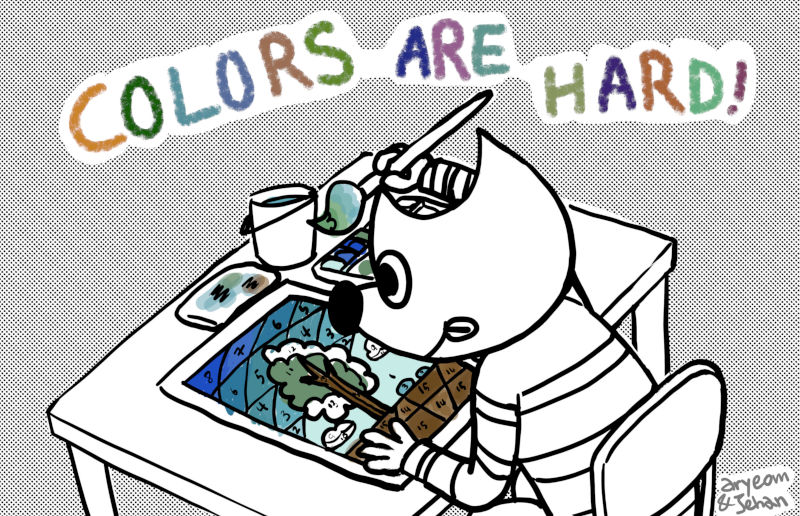
Quick Color picking
Similarly to painting tools, it is now possible to pick surrounding
colors on canvas with the Ctrl modifier, without having to switch to
Color Picker tool.
Click and drag to fill
In “Fill similar colors” and “Fill by line art detection” modes, you can
now keep the mouse button down to continue filling more areas.
Fill by line art detection
Finally, the highlight change on the Bucket Fill tool is a new algorithm
for painters, allowing to fill areas surrounded by “line arts”, while
trying to leave no unfilled pixels near the lines, and closing potential zones.
This feature, originated from the G’MIC plug-in as a
research paper, was
contributed by Jehan as work for the
IMAGE team of the
GREYC
laboratory (French Research Lab, affiliated to the
CNRS, the University
of Caen, and the engineering school
ENSICAEN), with important interface input
from Aryeom from ZeMarmot project.
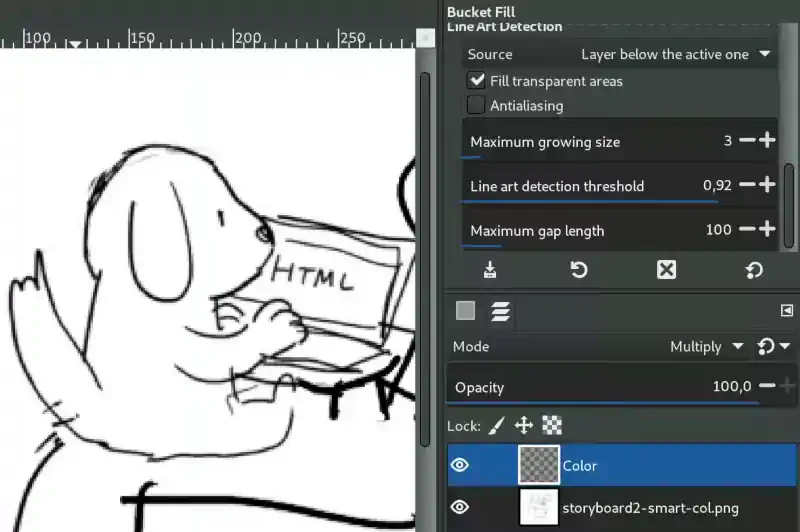
See also this technical blog
post.
Transformation tools
Ell improved various shortcomings on several transformation tools:
- The Scale tool now scales from the center, even when using numeric input.
- The Unified Transform tool defaults to preserving the aspect ratio
when scaling up or down. - New “Constrain handles” and “Around center” options to the
Perspective Transform tool’s GUI, which are similar to the
corresponding options of the Unified Transform tool. - New “Readjust” button in several transformation tools to readjust
transform handles based on the current zoom level. - Forward and backward transform directions can be linked, which allows
moving the handles without affecting the transformation, letting you
manually readjust their position.
Your browser does not support the video tag.
Heal and Clone tool
Michael Natterer improved the Heal tool by adding the “Sample merged” option
which allows painting changes on a separate layer to keep the original data
intact.
The Clone tool already had the “Sample merged” option. It has been
updated to also work similarly.
These changes are important for manipulating images without modifying
original pixels in a non-destructive fashion.
Better brushes
32-bit parametric brushes
Michael Natterer and Ell worked a lot on a better brush support in GIMP.
A major improvement for painters was making parametric brushes finally
32-bit float, following the high-bit depth move for color processing.
The main advantage will be to avoid posterization on large brushes,
especially with darker colors.
It is to be noted that raster brushes are still 8-bit. Promoting them to
32-bit float is also a planned future work.
Moreover, plug-ins only have access to 8-bit versions of high-precision
brushes and patterns. A new API, not available yet, will be required to
handle high-precision data.
Easy brush and pattern creation from clipboard
It was already possible to create new brushes and patterns on-the-fly
from the clipboard (i.e. image copied, typically with a Ctrl-c
shortcut). This was extremely practical, yet only allowed temporary
brushes and patterns.
These temporary brushes and patterns can now be duplicated as any other
data, therefore allowing to promote them to stored data for further reuse.
Though simple looking, this change is the result of an important code
migration into the core of GIMP (instead of being plug-in code),
performed by Michael Natterer, which may have further happy consequences
in a near future!
Open as Image
The “Brushes” dock now provides an “Open brush as image” button to
quickly open a brush file, allowing easier brush edits.
On-canvas layer selection
Anyone working with a lot of layers has sometimes experienced the
frustration of not finding a layer in the list, even though you see its
pixels in front of your eyes.
Jehan implemented a new generic canvas modifier Alt + middle click
allowing layers to be picked by clicking on pixels. The available layers will
be looped through (starting from the upper one) while the Alt key is held
and the picked layer name will be temporarily displayed in the status
bar. The interaction choices heavily benefited from input by
Aryeom, from the ZeMarmot project.
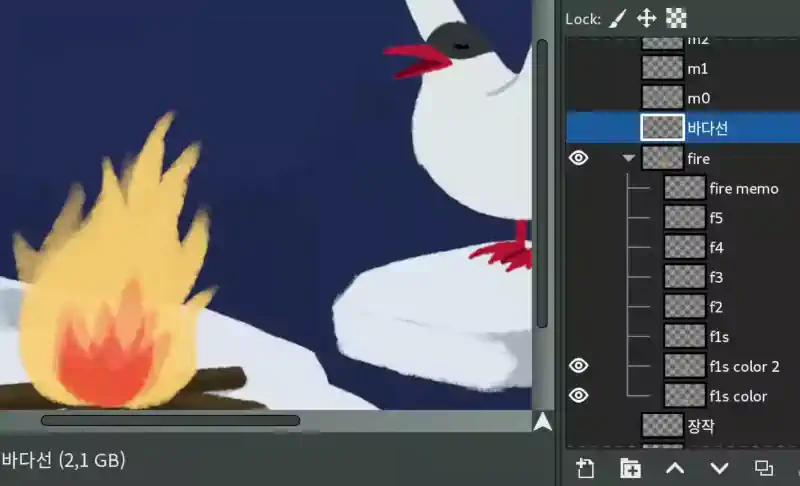
Faster and safer GIMP
As usual, many bugs were fixed and a lot of optimizations were made to
existing part of the code. Of them these 2 improvements are
particularly noteworthy:
Saving and exporting safer
Various parts of the file-writing code were made more
robust by not overwriting the file when an error occured. In particular
XCF saving and exporting to various image formats should be safer now.
Layer groups rendered faster
Layer groups are now rendered in bigger chunks rather than tile-by-tile
(this used to pretty much eliminate multithreading for groups), which
improves the rendering speed.
Improved macOS builds
HiDPI/Retina support was improved in the macOS/OSX build, fixing issues
with blurry icons.
Moreover the macOS package is finally signed, thus making the
installation process on this platform much less painful now!
And more!
In total, since GIMP 2.10.8, 775 commits were contributed (average of 5
commits a day) to the GIMP 2.10 branch (and more to other development
branches). This means a lot of bugs were fixed (41 bug reports were
closed during this development span), performance were improved,
and your work is made safer…
And as we should also count babl (66 commits for babl 0.1.62) and GEGL
(404 commits for GEGL 0.4.14), you can bet that this release is again as
awesome as ever!
Moreover 21 translations were updated. So we also want to thank all the
awesome translators who allow GIMP to be available in so many
languages around the world.
Plug-ins
DDS support
The third-party DDS
plug-in, originally developed by Shawn Kirst and Arne Reuter, is now part
of the GIMP core plug-ins, allowing GIMP to load or export DDS files out
of the box.
It is to be noted though that we are still looking for an active
maintainer for this plug-in if you want to see it improved since
we only fixed the minimum to get it up-to-date. If you want to step up, we welcome
patches!
Rewritten Spyrogimp plug-in
Elad Shahar, original author of the Spyrogimp plug-in rewrote it from
scratch completely, with more options and an automatic preview (by drawing
directly on a temporary layer, not as a GEGL preview).
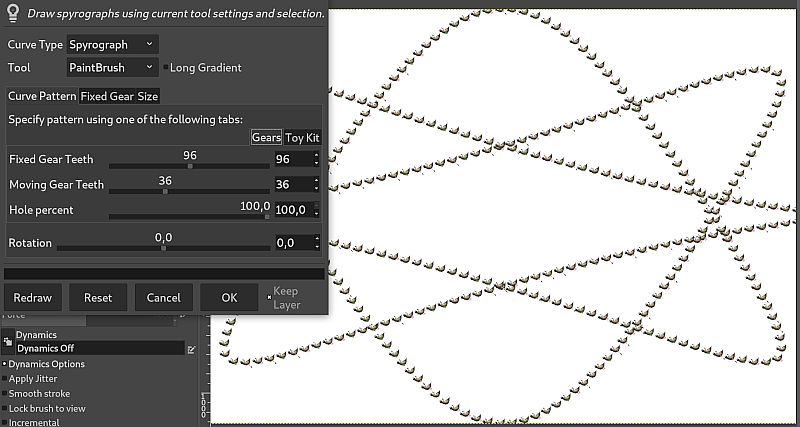
The old plug-in is still available, as its API may be used
by existing scripts, but is not available in the menus anymore as it is
replaced by the new version.
Filters
Circular, Linear, and Zoom Motion blurs got new on-canvas interactions
(simple lines) allowing easier visual tweaking of the blur settings.
GEGL and babl
This release of GIMP is accompanied by a hefty GEGL 0.4.14 release, featuring
a handful of under-the-hood improvements, as well as new user-facing additions.
Most excitingly, the standalone gegl tool, which can be used to apply GEGL
pipelines directly from the command-line, has seen a
massive rework of its integrated GUI
by Øyvind Kolås.
The new UI doubles as an image viewer and a graph editor, allowing real-time
non-destructive image manipulation.
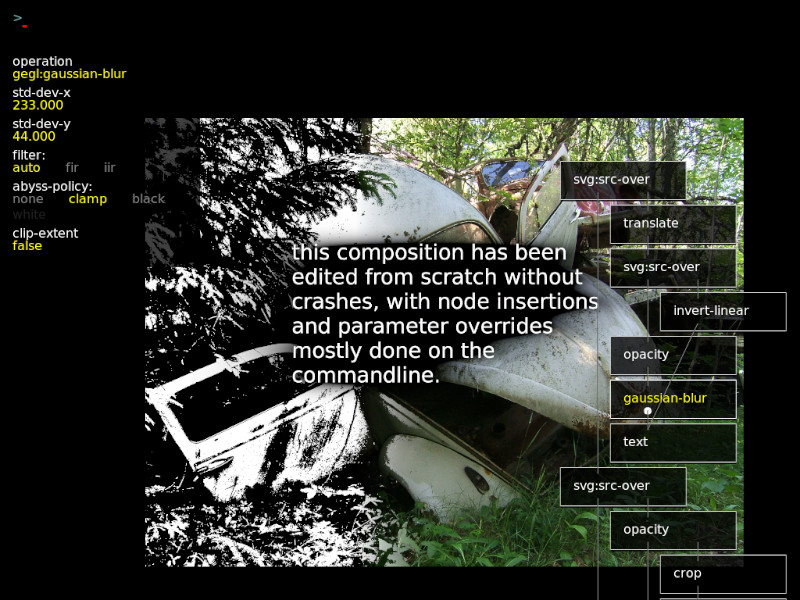
gegl binary features a reworked graphical editorAs well as acting as a non-destructive editor proof-of-concept, sporting such
snazzy features as touch-oriented interaction and Lua-based per-operation UI, it
also provides a testbed for new and existing GEGL features, such as mipmap rendering.
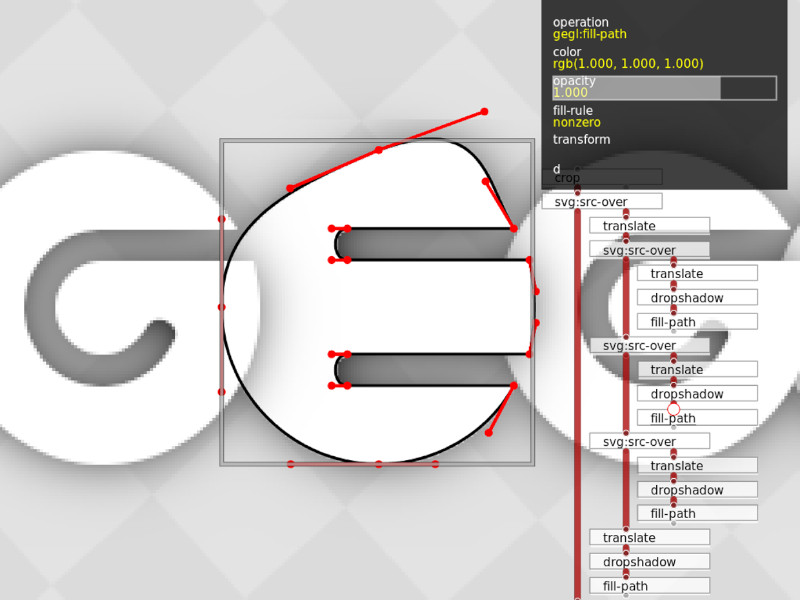
Øyvind Kolås has also
been working on more
deeply-ingrained CMYK support in both babl, which saw its 0.1.62 release
earlier this year, and GEGL.
This includes support for CMYK ICC profiles in babl (at this point, through LCMS2),
direct CMYK support as part of relevant GEGL functions and core operations,
and support for reading/writing CMYK data in TIFF and JPEG files.
While not done yet, this work goes towards adding first-class CMYK support to
GIMP.
Behind the scenes, this release saw various bug fixes and performance
improvements, including:
- refactoring of the parallelization framework
- swap tile-compression
- removal of the deprecated iterator API
- new operations in the workshop
- improvements to existing operations
See the GEGL relase notes
for more information.
Note for packagers: to build GEGL 0.4.14 on Win32, 2 commits will need
cherry-picking: commits
141a7aa7 and
b3ff0df0.
As often, we remind that you can donate to the project and personally
fund several of the people mentionned in this
news. This is a way to give back if you
appreciate the work and wish to help GIMP improve more!
Work on GIMP codebase is still going strong, not only for the stable GIMP
2.10.x branch, but also on the master branch with GTK+3 port. Hopefully
we will soon have some nice things to announce on this less visible side
of the development!
In the meantime, if you want to meet members of the GIMP team, as every
year, several members will be present during the Libre Graphics Meeting
2019 in Saarbruecken,
Germany, from May 29 to June 2. We have a few talks planned. Other
than this, we will likely hang around, so do not hesitate to catch one
of us for a talk!